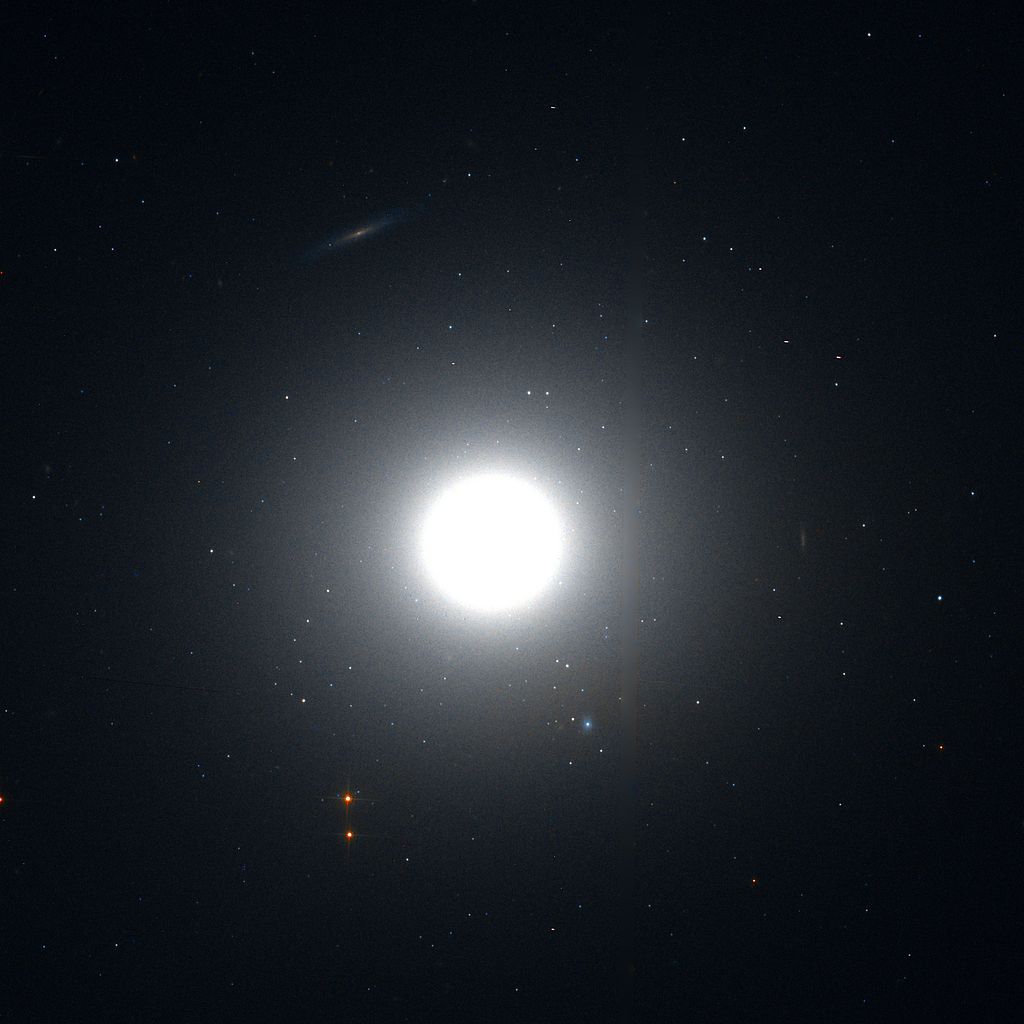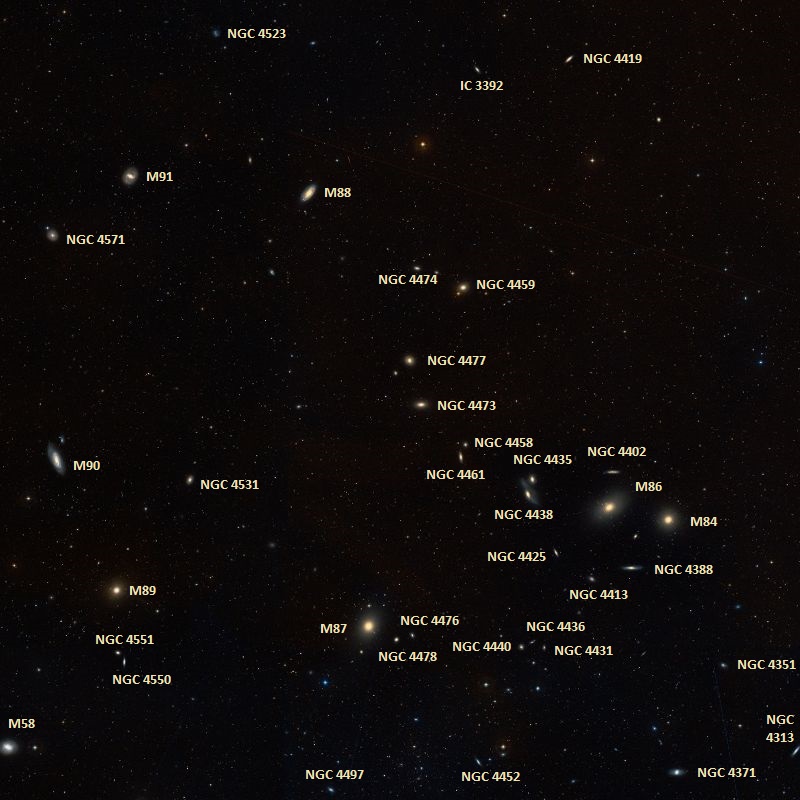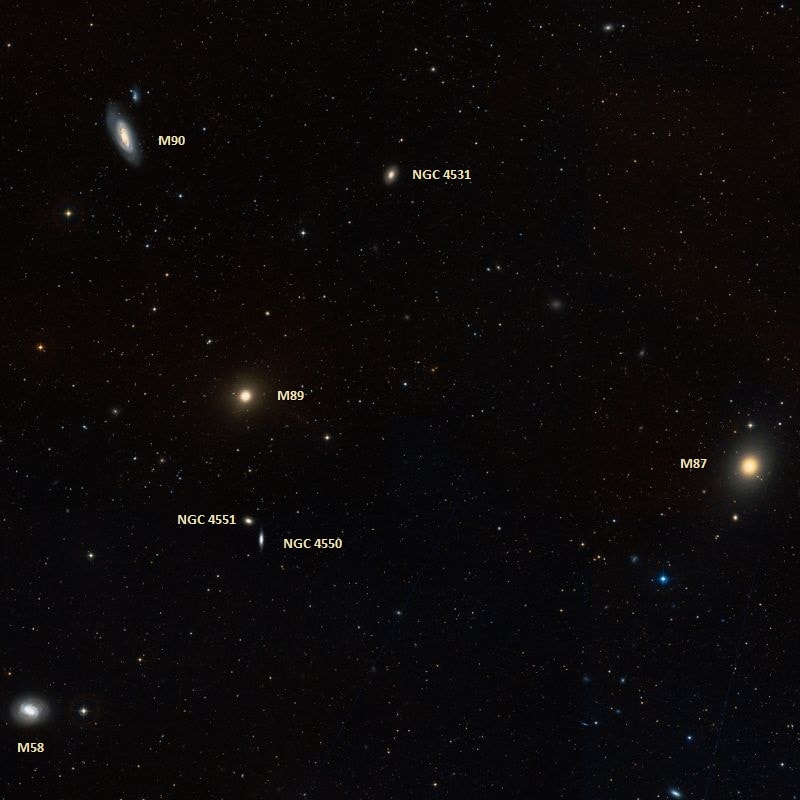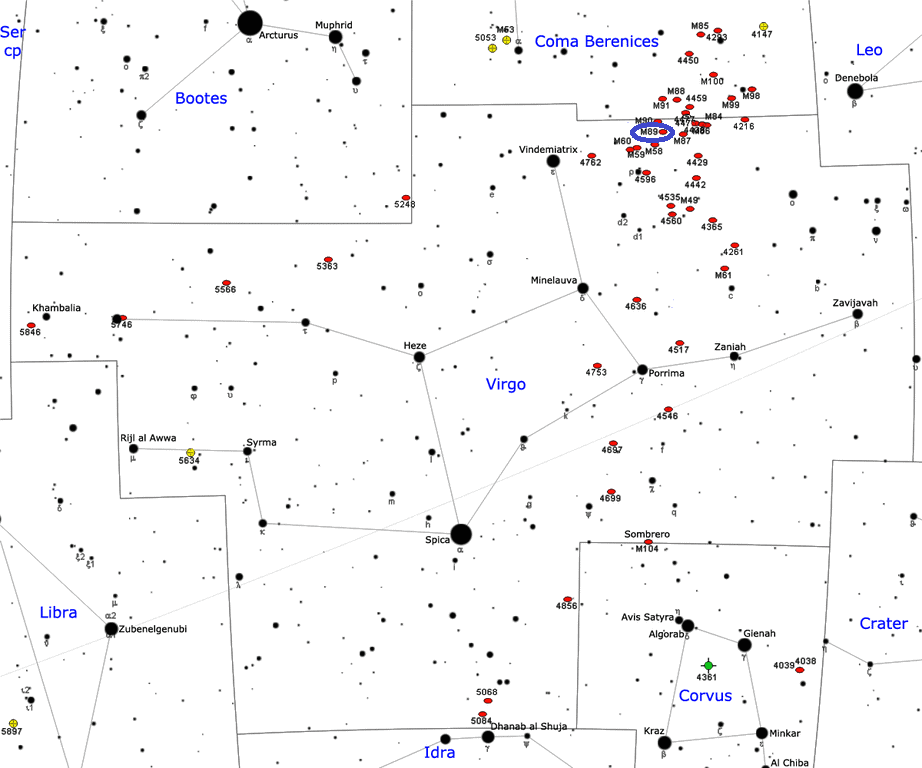Messier 89 (M89) is an elliptical galaxy located in the Virgo Cluster, in the constellation Virgo. The galaxy lies at an approximate distance of 50 million light years and has an apparent magnitude of 10.73. Its designation in the New General Catalogue is NGC 4552.
M89 occupies an area of 5.1 by 4.7 arc minutes of apparent sky, which corresponds to a spatial diameter of 80,000 light years. It is not as bright as some other Virgo Cluster members in the vicinity and can be difficult to make out in small telescopes. In 8-inch telescopes, the galaxy appears as a faint ball of light, with only about half its apparent size visible.
Messier 89 is positioned just south of the border between Virgo and Coma Berenices, about 60 percent of the way from the bright star Denebola in Leo to Vindemiatrix in Virgo. The galaxy can be found about 2 degrees west of the star Rho Virginis. It lies only 0.75 degrees southwest of the slightly brighter spiral Messier 90 and 1 degree northwest of the barred spiral Messier 58. The giant elliptical galaxy Messier 87 is only about a degree west of M89. The best time of year to observe M89 is during the spring.

Messier 89 appears almost perfectly spherical in shape, which is unusual because other galaxies of this type are elongated ellipsoids. The galaxy’s orientation relative to Earth may be responsible for this appearance and M89 may in fact be elliptical in shape. It is uncertain whether the galaxy is really spherical or if it is elongated, with the rotation axis pointing in our direction.
Messier 89 may have been an active quasar or radio galaxy in the past. It is surrounded by a structure of dust and gas extending across an area of up to 150,000 light years and has jets of heated particles extending about 100,000 light years outwards. The jet-like structure may be a smaller galaxy which is in the process of being torn apart by the tidal forces of M89. M89 also features a complex structure of shells and plumes around it, which likely formed as a result of mergers with other galaxies.
Messier 89 was the first galaxy discovered to have an extended envelope. The faint enveloping structure extending to about 150,000 light years was first seen in deep photographs taken by the British-Australian astronomer and photographer David Malin with the UK Schmidt Telescope, operated by the Australian Astronomical Observatory.
Messier 89 has a very rich population of globular clusters, with an estimated 2,000 globulars within 25 arc minutes of the galaxy. For comparison, the Milky Way is believed to have only 150 to 200 globulars.
The central supermassive black hole in M89 has an estimated mass of 1 billion solar masses.
Chandra observations in X-ray wavelengths have revealed two ring-like structures of hot gas in the galaxy’s core, indicating an outburst that occurred there 1 to 2 million years ago. Like many other members of the Virgo Cluster, the galaxy is experiencing ram-pressure stripping and losing gas as it moves through the dense intracluster medium.

Messier 89 was discovered by Charles Messier on March 18, 1781, the same night he discovered and catalogued seven other members of the Virgo Cluster – Messier 84, Messier 86, Messier 87 (Virgo A) and Messier 90 located in Virgo constellation and Messier 85, Messier 88 and Messier 91 in Coma Berenices – as well as the globular cluster Messier 92 in Hercules. This is what Messier wrote about M89:
Nebula without star, in Virgo, a little of distance from & on the same parallel as the nebula reported above, No. 87. Its light was extremely faint & pale, & and it is not without difficulty that one can distinguish it.
John Herschel catalogued M89 as h 1348 and later included it in his General Catalogue as GC 3097, describing the object as “pretty bright; pretty small; round; gradually much brighter toward the middle.”

FACTS
| Object: Galaxy |
| Type: Elliptical |
| Class: E0, LINER, HIISy2 |
| Designations: Messier 89, M89, NGC 4552, PGC 41968, UGC 7760, BWE 1233+1248, 2E 2786, 2E 1233.1+1249, 2MASX J12353988+1233217, MCG+02-32-149, RX J1235.6+1233, VCC 1632, VPC 1012, Z 70-184, Z 1233.1+1250 |
| Features: Appears almost perfectly spherical |
| Constellation: Virgo |
| Right ascension: 12h 35m 39.8s |
| Declination: +12°33’23” |
| Distance: 50 million light years (15.33 megaparsecs) |
| Number of stars: 100 billion |
| Apparent magnitude: +10.73 |
| Apparent dimensions: 5′.1 x 4′.7 |
| Radius: 40,000 light years |
| Redshift: 0.001134 |
| Heliocentric radial velocity: 340 km/s |
| Galactocentric velocity: 290 km/s |
LOCATION
